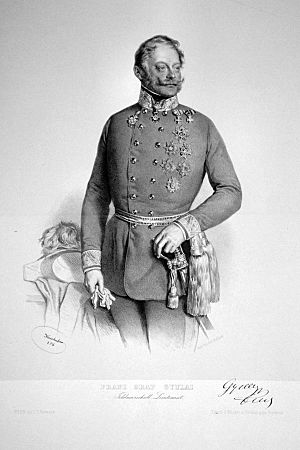Ferenc Gyulay facts for kids
Quick facts for kids
Ferenc Gyulay
|
|
|---|---|

Ferenc József Gyulay, 1850
|
|
| Born | 1 September 1799 Pest, Kingdom of Hungary |
| Died | 1 September 1868 (aged 69) Vienna, Austria-Hungary |
| Allegiance | |
| Years of service | 1816–1859 |
| Rank | Feldzeugmeister |
| Battles/wars | First Italian War of Independence Second Italian War of Independence |
Count Ferenc Gyulay (born September 1, 1799 – died September 1, 1868) was a Hungarian nobleman. He became an important general in the Austrian Empire army. He served as the Governor of Lombardy-Venetia, a region in Italy controlled by Austria. He also led the Austrian army in the Battle of Magenta, which they lost.
Contents
Ferenc Gyulay: A Hungarian General
Early Life and Military Start
Ferenc Gyulay was born in Pest, Hungary, on September 1, 1799. His father was Ignác Gyulay, also a nobleman.
Ferenc started his military career very young. In 1816, when he was just 17, he became a leutnant (a junior officer). He quickly moved up through the ranks. By 1820, he was an oberleutnant (first lieutenant). A year later, he became a hauptmann (captain).
He continued to gain experience in different army units. In 1826, he led a hussar brigade. By 1831, he was an oberst (colonel). He became a generalmajor (major general) in 1838. By 1846, he was a generalleutnant (lieutenant general). In 1847, he was in charge of military operations around Triest.
Facing Challenges in 1848
Gyulay's first real war experience came in 1848. This was a time of many revolutions across Europe. He was sent to Pula (a city in modern-day Croatia) to protect the Austrian fleet.
He had to make quick decisions to stop the ships from being taken by rebellious sailors. He removed Italian sailors from their duties. He also warned other ships at sea to do the same. He prepared the cities of Triest and Pola for defense. He armed the ships and found new crew members from local trading ships.
Gyulay also gathered troops who were retreating from Venice. His actions helped prevent a combined fleet from attacking important ports. The Battle of Custoza later helped ease the pressure on the coast. Gyulay's careful planning kept the area safe.
High Ranks and Key Roles
In 1849, Gyulay was promoted to lieutenant general (Feldmarschallleutnant). That summer, Emperor Franz Joseph made him the Austrian Minister of Defense. This meant he was in charge of the country's army.
He was involved in the Hungarian Revolution of 1848. He took part in the siege of Raab and the Battle of Komárom. However, he left Komárom early. This was partly because the Emperor sometimes made military decisions without his ministry. After this, he was sent to Milan to lead the 5th army division.
In 1857, Gyulay became the Governor of Lombardy-Venetia. This was an important role, as he was the main leader of this Austrian-controlled region in Italy. He lived in Milan.
The Italian Wars and Later Years
In early 1859, the Kingdom of Sardinia (also called Piedmont) teamed up with France. They started getting their army ready. This looked like they might invade Austrian territories in Italy. On April 23, Austria told Sardinia to stop preparing for war. When Sardinia refused, the Second Italian War of Independence began.
Count Gyulay was the commander of Austrian forces in Northern Italy. He was now a feldzeugmeister, a very high military rank. On April 29, he was ordered to cross the Ticino River, which was the border. French forces came to help their Sardinian allies.
On May 20, an Austrian force under Count Stadion was defeated at the Battle of Montebello. After this, Gyulay pulled his troops back into Austrian territory. He then suffered another defeat at the Battle of Palestro.
The French army then crossed into Austrian land. They captured the village of Boffalora sopra Ticino. Finally, on June 5, the main Austrian and French armies met at the Battle of Magenta. Gyulay's Austrian army was defeated. Because of this loss, he was called back to Vienna.
Emperor Franz Josef then took personal command of the Austrian army. He later lost another important battle, the Battle of Solferino. In one of his last military actions, Gyulay was sent to defend Mantua. He was unsuccessful and surrendered the city in 1866. Mantua then became part of the newly formed Italy.
Ferenc Gyulay died on his birthday, September 1, 1868, in Vienna, Austria.
Sources
- Deak, Istvan. Beyond Nationalism: A Social & Political History of the Habsburg Officer Corps 1848–1918. Oxford University Press, 1990. ISBN: 0-19-504505-X.
- Morris, Charles. One Hundred Years of Conflict Between the Nations of Europe: The Causes and Issues of the Great War. The John C. Winston Company, Philadelphia, PA, 1914.
See also
 In Spanish: Ferenc Gyulai para niños
In Spanish: Ferenc Gyulai para niños

